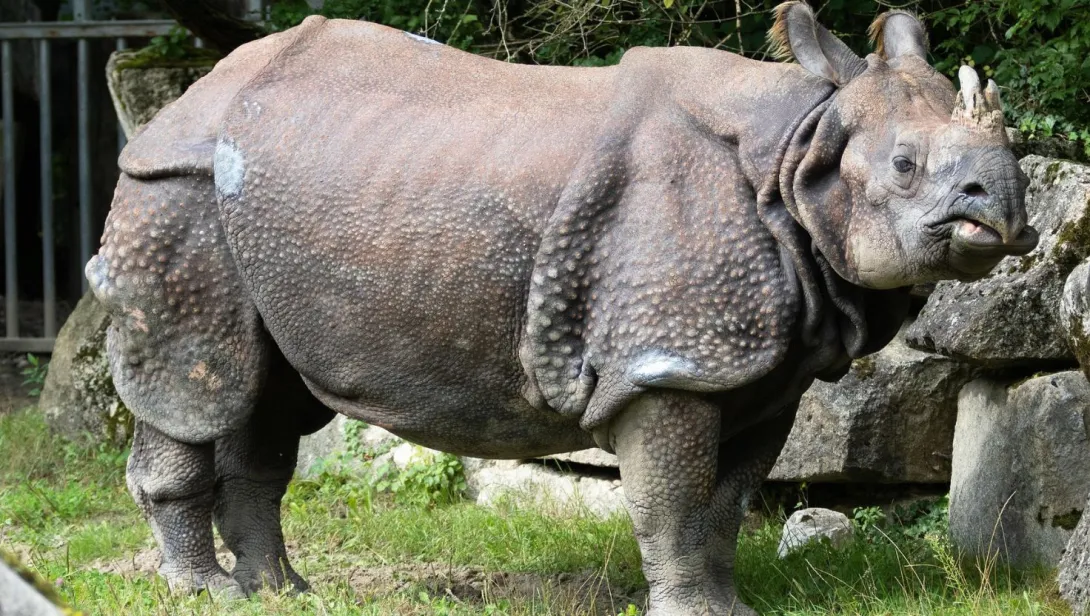Skip to main content
Introduction
- The Indian Rhinoceros (Rhinoceros unicornis), also known as the Greater One-Horned Rhinoceros, is one of the largest rhino species.
- They are known for their single horn and armor-like skin folds, which give them a prehistoric appearance.
- Indian Rhinos are native to the Indian subcontinent and are primarily found in protected areas.
Physical Characteristics
- Indian Rhinos have a massive, robust body, with males weighing between 4,000 to 6,000 pounds (1,800 to 2,700 kg) and females slightly smaller.
- Their skin is thick and gray, with distinctive skin folds that resemble armor plating.
- They have a single horn made of keratin, which can grow up to 10 inches (25 cm) in length.
- Indian Rhinos have a prehensile upper lip, which helps them grasp and pull vegetation.
Habitat and Distribution
- Indian Rhinos are found in the Indian subcontinent, including countries like India and Nepal.
- They inhabit grasslands, wetlands, and riverine forests, often near water sources.
- Indian Rhinos are primarily found in protected areas such as Kaziranga National Park and Chitwan National Park.
Diet and Foraging
- Indian Rhinos are herbivorous and primarily feed on grasses, leaves, fruits, and aquatic plants.
- They consume up to 150 pounds (68 kg) of food daily.
- Indian Rhinos use their prehensile upper lip to grasp and pull vegetation.
- They are grazers, feeding on grasses and other low-lying vegetation.
Behavior and Communication
- Indian Rhinos are solitary animals, except for mothers with calves or during mating season.
- They communicate through vocalizations such as grunts, snorts, and growls, as well as through scent markings.
- Indian Rhinos are territorial and mark their territory with dung piles and urine.
- They are generally aggressive and will charge at perceived threats, including humans and other animals.
Reproduction and Lifespan
- Female Indian Rhinos give birth to one calf after a gestation period of about 15 to 16 months.
- Calves are born weighing around 130 to 150 pounds (60 to 70 kg) and are cared for by their mothers.
- Calves stay with their mothers for 2 to 4 years before becoming independent.
- Indian Rhinos have a lifespan of 35 to 45 years in the wild and up to 50 years in captivity.
Conservation Status
- Indian Rhinos are classified as Vulnerable on the IUCN Red List, with populations increasing due to conservation efforts.
- There are an estimated 3,700 Indian Rhinos left in the wild, primarily in India and Nepal.
- They are threatened by poaching for their horns, which are highly valued in traditional medicine and as status symbols.
- Conservation efforts include protected areas, anti-poaching measures, and community-based conservation programs.
Unique Adaptations
- Indian Rhinos have a single horn made of keratin, which is used for defense and foraging.
- Their thick skin and skin folds protect them from predators and environmental hazards.
- They have excellent hearing and sense of smell, which help them detect predators and other rhinos.
- Indian Rhinos are aggressive and territorial, often charging at perceived threats.
Cultural Significance
- Indian Rhinos are revered in many South Asian cultures as symbols of strength and resilience.
- They are featured in mythology, literature, and art across the Indian subcontinent.
- In some cultures, Indian Rhinos are considered spiritual guides and protectors.
Fun Facts
- Indian Rhinos can run at speeds of up to 34 mph (55 km/h).
- They are solitary animals, except for mothers with calves or during mating season.
- Indian Rhinos can go without water for several days, getting most of their moisture from the plants they eat.
- They are keystone species, playing a crucial role in maintaining ecosystem balance by shaping vegetation.
- Indian Rhinos have poor eyesight but excellent hearing and sense of smell.
- They are not true dogs but are more closely related to wolves and jackals.
Threats to Indian Rhinos
- Poaching for their horns is the most significant threat to Indian Rhinos.
- Habitat loss due to agriculture and urbanization is a major threat to Indian Rhinos.
- Human-wildlife conflict often results in Indian Rhinos being killed by farmers protecting crops.
- Climate change is altering their habitats, making it harder for them to find food and water.
Conservation Efforts
- Protected areas and wildlife reserves have been established to safeguard Indian Rhino habitats.
- Anti-poaching initiatives and stricter wildlife protection laws have helped reduce illegal hunting.
- Community-based conservation programs work to reduce human-wildlife conflict.
- Global awareness campaigns highlight the importance of Indian Rhino conservation and encourage public support.
